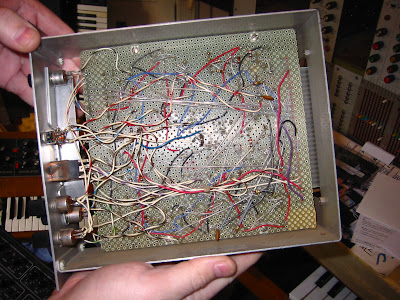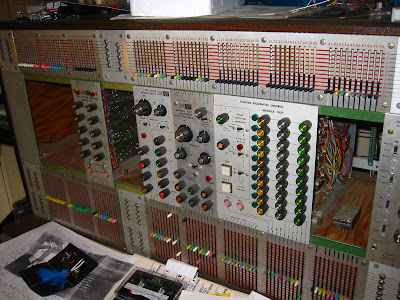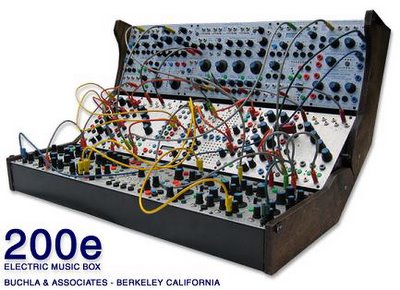
Showing posts sorted by date for query Buchla 400. Sort by relevance Show all posts
Showing posts sorted by date for query Buchla 400. Sort by relevance Show all posts
Thursday, May 17, 2007
Barry Schrader, Morton Subotnick and John Payne - CalArts studio B-304
"The following flickr stream was from CalArts studio B-304 taken in the fall of 1976 featuring Barry Schrader, Morton Subotnick and John Payne and a whole lotta Buchla 500. John as you may remember came up a couple of months ago on Matrixsynth in the posting regarding Mort's use of the 300 at Ircam [link]. He went on in later years to become the Assistant Dean of the CIA School of Music and founder of it's Music Tech department. Photo b_304.2 has a good view of the entire studio, save the three other JBL's which are out of frame (it was a quad studio - there was one in each corner)."
b_304.1 pictured.
"Barry Schrader, Morton Subotnick and John Payne stand in front of the Buchla 500 in CalArts' sudio B-304 in the fall of 1976."
via Peter Grenader.
Posts featuring Barry Schrader
Posts featuring Morton Subotnic
Posts featuring John Payne
Update: As always check the comments for more info.
via Peter:
"There are two more 500's that I know off - at Evergreen and another somewhere in Europe (pardon the senior moment, i don't remember where exactly). This is not to say there aren't others...I'm just not aware of any. The one in the photo here was the first - the development system Don constructed while on staff at CalArts. I do know the 500 was adondoned quickly and resurfaced as the 300 series which included direct routing of computer control the various modules (259 VCO and 292C Gate for example) -and- the digital VCOs."
"the box screwed into the side of the main cabinet is a speaker selector which i f i remember correctly wasn't on line. Another bit of trivia - this was taken about the time of Mort's Game Room project that Gary Chang, Jill Frazer, Darrell Johansen, Sue Harvey and I worked on. The room next to 304 (other side of the wall which is shown behind the Buchla) was 305. It had a large 100 system (three cabinets) and for the Game Room we cut a hole in the base of that wall to run audio cables out from the tape machines to play quad audio snippets into the game area. This also took signals directly from the game board in 305 where signals were decoded and sent to the various controllers (audio, film, Buchla-controlled OCR light dimmers, etc.).
Against the other wall - opposite the one behind the 500 - was studi oB-303, which was pretty much a duplicate of this one sans the computer control - so it was a 200 studio, not a 500 studio. It also had the huge JBL monitors which were hung form the ceiling on metal brackets made by Chas Smith (which are still in place today). There's a photo of 303 at Barry's Schrader's website: link
Most people preferred working in 303, mainly because the 258's were easier to get to. On the 500 system they were all on the top row, which was a pain for most. The upside - studio time was easy to book in 304 for this reason I spent a lot of the early mornings here - tarting usually at 4AM and going until classes began around 9."
via an anonymous comment:
"Evergreen has/had an early 300 its computer is non functional. There were 3 500s from what i understand, 1 went to Norway, 1 to a campus studio in NY and the 3rd was of course at CalArts..
the Norway one was moved around a lot as it was purchased by 2 or 3 studios/organizations and because of its fragile nature it didnt survive.. it was apparently parted out after it became nonfunctional.
The CalARTs system was also disassembled and parts were sold to various buyers around the US in the famouse 90's sale ..nobody is too sure what happened to the digial components..
the 3rd that was in NY was sold to a collector in the 90's, tho it should be noted that that system was returned to Buchla for upgrading/overhaul in the late 70's and was reassembled with 300 series components, so it is more of a 300 now then 500... I don't believe it has been tested or turned on in over a decade.
another note, there were 2 versions of the 300.. the early system used tech from the 500 (the gating matrix for example - which controlled early versions of the 281 and 292B gates - the remote function on later 281s and 292Cs was never implemented) the later 300s were more of a self contained system ( with 200 modules for processing ) which eventually became the Touché and the 400."
Tuesday, September 05, 2006
New Modcan Modules
 Via Paul Sop, aka Doktor Future:
Via Paul Sop, aka Doktor Future:"Bruce Duncan of Modcan has released some new modules. There's the CV Recorder, of which you posted a prototype panel before. There's also the surprise module: the VDCO, a voltage controlled digital controlled oscillator! It's is a curious mix of digital wavetables ala the Miniwave, but also single operator FM. It's very 'Buchla' like (don't hit me). He's also now released them in the original Modcan format, the 'A'Series. These links have pics and MP3's:
CV Recorder:
the A Version
the B Version
VDCO:
the A Version
the B Version
The CV Recorder costs 550 in A and B, and the VDCO costs 400 and 410 (A and B respectively)."
Tuesday, August 22, 2006
The $500 Buchla
Title link takes you to a bit of Buchla history.
Excerpt:
"In contrast to Moog's industrial stance, the rather counter-cultural design philosophy of DONALD BUCHLA and his voltage-controlled synthesizers can partially be attributed to the geographic locale and cultural circumstances of their genesis. In 1961 San Francisco was beginning to emerge as a major cultural center with several vanguard composers organizing concerts and other performance events. MORTON SUBOTNICK was starting his career in electronic music experimentation, as were PAULINE OLIVEROS, RAMON SENDER and TERRY RILEY. A primitive studio had been started at the San Francisco Conservatory of Music by Sender where he and Oliveros had begun a series of experimental music concerts. In 1962 this equipment and other resources from electronic surplus sources were pooled together by Sender and Subotnick to form the San Francisco Tape Music Center which was later moved to Mills College in 1966.
Because of the severe limitations of the equipment, Subotnick and Sender sought out the help of a competent engineer in 1962 to realize a design they had concocted for an optically based sound generating instrument. After a few failures at hiring an engineer they met DONALD BUCHLA who realized their design but subsequently convinced them that this was the wrong approach for solving their equipment needs. Their subsequent discussions resulted in the concept of a modular system. Subotnick describes their idea in the following terms:
'Our idea was to build the black box that would be a palette for composers in their homes. It would be their studio. The idea was to design it so that it was like an analog computer. It was not a musical instrument but it was modular...It was a collection of modules of voltage-controlled envelope generators and it had sequencers in it right off the bat...It was a collection of modules that you would put together. There were no two systems the same until CBS bought it...Our goal was that it should be under $400 for the entire instrument and we came every close. That's why the original instrument I fundraised for was under $500.'
Buchla's design approach differed markedly from Moog. Right from the start Buchla rejected the idea of a "synthesizer" and has resisted the word ever since. He never wanted to "synthesize" familiar sounds but rather emphasized new timbral possibilities. He stressed the complexity that could arise out of randomness and was intrigued with the design of new control devices other than the standard keyboard. pp39-40"
Anyone else thinking Starkey? Coincidentally the recent Starkey went for $541 on the bay. Yeah, I know I'm stretching it...
via Peter Grenader on AH.
Excerpt:
"In contrast to Moog's industrial stance, the rather counter-cultural design philosophy of DONALD BUCHLA and his voltage-controlled synthesizers can partially be attributed to the geographic locale and cultural circumstances of their genesis. In 1961 San Francisco was beginning to emerge as a major cultural center with several vanguard composers organizing concerts and other performance events. MORTON SUBOTNICK was starting his career in electronic music experimentation, as were PAULINE OLIVEROS, RAMON SENDER and TERRY RILEY. A primitive studio had been started at the San Francisco Conservatory of Music by Sender where he and Oliveros had begun a series of experimental music concerts. In 1962 this equipment and other resources from electronic surplus sources were pooled together by Sender and Subotnick to form the San Francisco Tape Music Center which was later moved to Mills College in 1966.
Because of the severe limitations of the equipment, Subotnick and Sender sought out the help of a competent engineer in 1962 to realize a design they had concocted for an optically based sound generating instrument. After a few failures at hiring an engineer they met DONALD BUCHLA who realized their design but subsequently convinced them that this was the wrong approach for solving their equipment needs. Their subsequent discussions resulted in the concept of a modular system. Subotnick describes their idea in the following terms:
'Our idea was to build the black box that would be a palette for composers in their homes. It would be their studio. The idea was to design it so that it was like an analog computer. It was not a musical instrument but it was modular...It was a collection of modules of voltage-controlled envelope generators and it had sequencers in it right off the bat...It was a collection of modules that you would put together. There were no two systems the same until CBS bought it...Our goal was that it should be under $400 for the entire instrument and we came every close. That's why the original instrument I fundraised for was under $500.'
Buchla's design approach differed markedly from Moog. Right from the start Buchla rejected the idea of a "synthesizer" and has resisted the word ever since. He never wanted to "synthesize" familiar sounds but rather emphasized new timbral possibilities. He stressed the complexity that could arise out of randomness and was intrigued with the design of new control devices other than the standard keyboard. pp39-40"
Anyone else thinking Starkey? Coincidentally the recent Starkey went for $541 on the bay. Yeah, I know I'm stretching it...
via Peter Grenader on AH.
Tuesday, June 13, 2006
Buchla - New Flickr Shots
 more from arrrika.
more from arrrika. According to rick of electricmusicbox, "thats the buchla 406 ( keyboard equipted 400) from Cantos.. i know that instrument well as I spend alot of time at Cantos."
Saturday, May 20, 2006
The First ARP 2500
 You are looking at the first ARP 2500. It's home is at the New England Synthesizer Museum in Nashua, New Hampshire. I was fortunate enough to actually see it in person a couple of years ago. It was an amazing experience, standing in front of it, realizing what it is. I took a few shots including this one. Title link will take you to them including a much larger version of this one. Also note the SYNTHE license plate on top. : )
You are looking at the first ARP 2500. It's home is at the New England Synthesizer Museum in Nashua, New Hampshire. I was fortunate enough to actually see it in person a couple of years ago. It was an amazing experience, standing in front of it, realizing what it is. I took a few shots including this one. Title link will take you to them including a much larger version of this one. Also note the SYNTHE license plate on top. : )What is just as amazing is how Dave Hillel Wilson, the curator of the museum, acquired it. There are amazing deals and then there is this... But don't feel to bad, as you will see, somehow karma has a way of balancing things, but somehow I think Dave still came out ahead. : )
"Many years ago a man tried to sell an ARP 2500 to Daddy's Junky Music in Nashua, New Hampshire. They didn't want it, so they referred him to me. I looked at it and was afraid to offer too little; I offered $500 US. He was expecting to get $50 for it, so he was so happy he threw in his gray meanie 2600 as well. Later Alan R. Pearlman confirmed that this 2500 was the first ever made.
Best purchase I didn't make - I looked at a Buchla Music Easel (before I knew much, but after I thought I new everything) and said it wasn't as good as an ARP Axxe. The guy offered it to me for $400 US dollars and I said no. Boy have I made some stupid mistakes in my lifetime!! (Some guy bought it for 400, turned right around and sold it to a dealer for $1200, who sold it to someone in Europe for $2400, so it's long gone)."
- David Hillel Wilson
Curator
New England Synthesizer Museum
_DWilSynth[]aol.com
_www.synthmuseum.com/nesm
Update: a few more pics below. Note David Hillel Wilson passed away in 2010.



Sunday, October 30, 2005
Buchla 200e Analog vs. Digital
Update. Some notes worth posting via the comments:
Rick: "correction the new 261e Osc uses digital sine generation with pure analogue waveshaping.. where as the 259e uses digital generation and waveshaping in the form of "non-linear digital waveshaping"... read about this process..no other manufacturer offers this. FYI the Buchla 500, 300, 400 and 700 all used digital Oscillators with analogue output stages as is done in the 200e.. this is nothing new for Don.. it dates back to the early 70's instruments. in most cases the ear cant precieve the difference between an analogue or digitally generated sine tone...mine can't anyway."
Orth: "Well, after reading the FAQ, maybe we should just say that the Buchla is beyond traditional definitions of analog v digital. I mean jeez, that monster is something else at that point. a/d/a/d/a/d/a/d/a/d/a "
There's been some interesting discussion on the Buchla 200e on AH, including it's high price tag. You can pick and chose modules, but the listed systems start at $9300 and go on up to $27,400. See for yourself. What I actually found most interesting is that the system is a digital and anlog hybrid with fully digital oscillators. Buchlas are considered to be the holy grail in the synthesizer world along with just a few select others. Their sound and flexibility are considered to be worth it's high price. What's interesting to me is that one of the most common arguments you hear in the analog vs. digital debate is how analog sounds warmer and somehow better than digital. Some even argue that DCOs, digitally controlled oscillators, aren't truly analog and do not sound as good as their counterpart VCOs, voltage controlled oscillators. Yet Buchla went with digital. It's interesting when you consider the quality and pricetag of a Buchla. The title link takes you to the 200e faq which explains why.

Rick: "correction the new 261e Osc uses digital sine generation with pure analogue waveshaping.. where as the 259e uses digital generation and waveshaping in the form of "non-linear digital waveshaping"... read about this process..no other manufacturer offers this. FYI the Buchla 500, 300, 400 and 700 all used digital Oscillators with analogue output stages as is done in the 200e.. this is nothing new for Don.. it dates back to the early 70's instruments. in most cases the ear cant precieve the difference between an analogue or digitally generated sine tone...mine can't anyway."
Orth: "Well, after reading the FAQ, maybe we should just say that the Buchla is beyond traditional definitions of analog v digital. I mean jeez, that monster is something else at that point. a/d/a/d/a/d/a/d/a/d/a "
There's been some interesting discussion on the Buchla 200e on AH, including it's high price tag. You can pick and chose modules, but the listed systems start at $9300 and go on up to $27,400. See for yourself. What I actually found most interesting is that the system is a digital and anlog hybrid with fully digital oscillators. Buchlas are considered to be the holy grail in the synthesizer world along with just a few select others. Their sound and flexibility are considered to be worth it's high price. What's interesting to me is that one of the most common arguments you hear in the analog vs. digital debate is how analog sounds warmer and somehow better than digital. Some even argue that DCOs, digitally controlled oscillators, aren't truly analog and do not sound as good as their counterpart VCOs, voltage controlled oscillators. Yet Buchla went with digital. It's interesting when you consider the quality and pricetag of a Buchla. The title link takes you to the 200e faq which explains why.

PREVIOUS PAGE
HOME













© Matrixsynth - All posts are presented here for informative, historical and educative purposes as applicable within fair use.
MATRIXSYNTH is supported by affiliate links that use cookies to track clickthroughs and sales. See the privacy policy for details.
MATRIXSYNTH - EVERYTHING SYNTH













© Matrixsynth - All posts are presented here for informative, historical and educative purposes as applicable within fair use.
MATRIXSYNTH is supported by affiliate links that use cookies to track clickthroughs and sales. See the privacy policy for details.
MATRIXSYNTH - EVERYTHING SYNTH





























